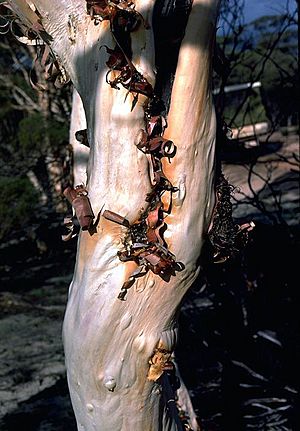Melaleuca exuvia facts for kids
Quick facts for kids Melaleuca exuvia |
|
|---|---|
 |
|
| Melaleuca exuvia bark | |
| Scientific classification | |
| Genus: |
Melaleuca
|
| Species: |
exuvia
|
Melaleuca exuvia is a unique plant from the myrtle family, Myrtaceae. It grows only in the southern part of Western Australia. You can easily spot it because of its special rough bark. This bark peels off to show a new, smooth, salmon-pink layer underneath. This plant was officially named in 2004, but before that, it was thought to be part of another plant called Melaleuca uncinata.
Contents
What Does Melaleuca exuvia Look Like?
Melaleuca exuvia is a large shrub that can grow up to 6 meters (about 20 feet) tall. It has rough, pinkish-grey bark that peels off every year. This special peeling pattern is called "minni ritchi." When the old bark peels, it shows new, smooth, salmon-pink bark underneath.
This plant often has more than one main stem. Its top part, called the crown, can spread out up to 9 meters (about 30 feet) wide.
Leaves
The leaves of Melaleuca exuvia stand upright. They are shaped like cylinders, or are narrow and oval. They are round when you look at them from the side. The leaves are usually 7 to 30 millimeters (about 0.3 to 1.2 inches) long. They are also quite thin, about 0.6 to 1.3 millimeters (0.02 to 0.05 inches) wide. Most of the leaves have a small hook at their tip.
Flowers
The flowers of Melaleuca exuvia are white to yellow. They grow in groups of three, with 3 to 8 such groups forming a larger head. The petals of the flowers are oval-shaped and about 1 to 1.4 millimeters (0.04 to 0.06 inches) long. Inside the flower, there are five bundles of stamens. Stamens are the parts of a flower that produce pollen. Each bundle has 5 to 8 stamens.
The plant usually flowers in late spring. After the flowers, it produces woody capsules, which are like small seed pods. These capsules are about 4.5 to 5 millimeters (0.18 to 0.20 inches) long. They often stay on the stems for many years.
How Did It Get Its Name?
Scientists officially described and named Melaleuca exuvia in 2004. This was done by two scientists, Lyndley Craven and Brendan Lepschi. They wrote about it in a science journal called Australian Systematic Botany. They found the first plant they studied near a place called Key Rocks, close to Norseman.
The second part of the plant's name, exuvia, comes from a Latin word. It means "cast skin" or "slough." This name was chosen because of the plant's unique bark, which peels off like an animal shedding its skin.
Where Does It Grow?
This type of melaleuca plant grows in a small area in Western Australia. You can find it in places like the Lort River area, near Lake Johnson, and around the Queen Victoria Spring districts. These areas are part of the Coolgardie, Great Victoria Desert, and Mallee regions.
Melaleuca exuvia likes to grow in sandy soils. It is often found near small rivers or channels where water flows. It also grows at the edges of salt lakes.
Is It Endangered?
The Government of Western Australia Department of Parks and Wildlife keeps track of plants and animals. They have listed Melaleuca exuvia as "not threatened." This means that currently, there are enough of these plants, and they are not in danger of disappearing.

